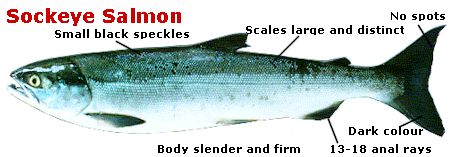
Sockeye Salmon or Red Salmon (Oncorynchus nerka)
Identification:
Juveniles: Parr marks mostly above the lateral line. Adipose fin clear, not pigmented. No spots on dorsal fin.
Adults: Dorsal surface of body and head is steel-blue to green-blue with fine black speckling. Sides are bright silver, and the ventral surface is white to silver. Length approximately 24 inches.

Spawning adults: males have pale green to olive head and lower jaw, black on the snout. The back and sides are bright red to dirty red-grey, and the ventral surface is dirty-red to grey. The upper jaw develops into an elongate hooked snout, and a slight hump forms behind the head. Females are a darker grey-red colour.
Life History: Primarily anadromous, but some populations (Kokanee) spend their entire life cycle in freshwater. Sexually maturing anadromous adults migrate back to their spawning rivers at different times, ranging from late spring to mid-summer, finally spawning in late summer and autumn (late July to January). The female selects the redd site, generally adjacent to lake rearing areas, over gravel and in areas of riffle and upwellings. She then digs the nest(s) and deposits her eggs which are simultaneously fertilized by the male. Fecundity can vary from 2000 to 5000 eggs per female. Both females and males die after spawning is completed. The eggs eventually hatch, and the fry spend some time beneath the gravel cover before emerging. After emergence, the juveniles may spend a few weeks to three years in freshwater, with the most common being one or two years. Typically, juvenile anadromous sockeye rear in the lake for one to three years after emergence from the gravel bed, however some populations utilize the spawning stream areas to rear. The adults then spend one to four years in the ocean growing and maturing before returning again to spawn.
Feeding: Sockeye fry feed on planktonic crustaceans, chironomid pupae and terrestrial insects. In the ocean, the fish are pelagic and feed on pelagic prey such as zooplankton, squid and small fish.
References:
Groot, C and Margolis, L. Eds. 1991. Pacific Salmon Life Histories. UBC Press. Vancouver, B.C.
Juvenile fish id key. 1995. The Streamkeepers Handbook: a Practical Guide to Stream and Wetland Care. Community Involvement Division, Salmonid Enhancement Program, Department of Fisheries and Oceans. Vancouver, B.C.
Scott, W and Crossman, E. 1973. Freshwater Fishes of Canada. Fisheries Research Board of Canada. Bulletin 184. Ottawa, Ontario.
© 2009 Veins of Life Watershed Society / All Rights Reserved / if you wish to use any info for commercial or non commercial usage you must obtain permissions from The Veins of Life Watershed Society